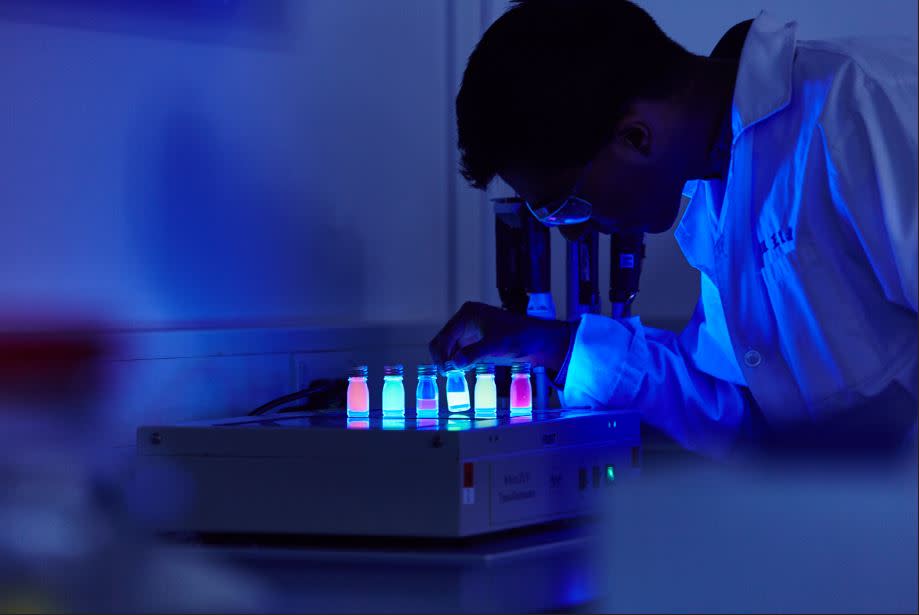How one of the UK’s most innovative Medtech companies is changing the speed and accuracy of cervical cancer diagnosis
By Bruntwood SciTech

Founded in 2006 after a successful collaboration between the University of Sheffield and Sheffield Teaching Hospitals NHS Foundation Trust (STHFT), Zilico is developing the next generation of diagnostic devices that remove subjectivity, increase accuracy and deliver results in real-time for cervical cancer diagnosis.
With its HQ located at Manchester Science Park, part of the Bruntwood SciTech network, we caught up with CEO Sameer Kothari to hear more about Zilico’s pioneering work and how partnerships and collaboration have helped their journey to success.
Tell us a bit more about what Zilico does?
Zilico has developed a technology which recognises the changes in tissue structure using the electrical properties of cells. Many diseases still rely on visual diagnosis by a clinician, which is open to subjectivity and, additionally, visual indicators can be lacking or misleading. Our non-visual technique, using Electrical Impedance Spectroscopy (EIS) promotes early detection, allowing the clinician to use appropriate early intervention which can prevent the disease from further progression.
The company introduced ZedScan, a diagnostic in the cervical cancer pathway which is now being used routinely in 12 hospitals across the UK, including Sheffield Teaching Hospitals NHS Foundation Trust, Birmingham Women’s and Children’s NHS Foundation Trust, University Hospitals of North Midlands NHS Trust, Manchester University NHS Foundation Trust and Aberdeen Royal Infirmary. University hospitals within Europe have also adopted the technology.
This period has enabled us to publish real-world data on ZedScan and also collect vital user feedback as we drive further adoption across the UK and globally. The ability to correctly identify women who do or don’t have disease is pivotal to the success of any screening programme. ZedScan has demonstrated greater accuracy in detecting cervical disease and supports better management of patients.
Why is the speed and accuracy of ZedScan so important for cervical cancer diagnosis?
Despite robust cervical screening, HPV vaccination programmes and education, 870 women in the UK still lose their lives to cervical cancer each year and around 311,000 women worldwide. Cervical cancer is a preventable cancer, if we can diagnose it earlier. The changes to cells during the early stages of the disease are more subtle and therefore more challenging to detect visually.
A non-visual technology such as EIS enables clinicians to detect these subtle changes earlier. There is clear benefit for the patient but also benefits to hospital systems and for payers of healthcare.
ZedScan provides clinicians with additional information and offers diagnostic confidence, meaning they can either treat women at first visit or, follow the ‘Watch and Wait’ pathway, or return patients to routine screening when no disease is present.
How does ZedScan work?
ZedScan is a unique diagnostic device because it uses electrical impedance technology to identify cell changes that cannot always be seen with standard colposcopy and does not rely on visual aceto-white changes.
EIS is an objective, scientifically-proven method to differentiate between normal, pre-cancerous and cancerous tissues (neoplasias). EIS exploits the different electrical resistivity of each specific tissue type based on its cellular structure and is appropriate for the diagnosis of various cancers and pre-cancerous conditions.
It has been designed to seamlessly integrate into standard colposcopy, helping to minimise colposcopic subjectivity, increase diagnostic accuracy and deliver immediate results. These characteristics allow for the improvement and extension of clinical screening programmes globally.
ZedScan also delivers results in real-time, identifying women where treatment is appropriate, increasing clinician confidence to treat women at first visit or return them to routine cervical surveillance or screening when no disease is indicated, reducing follow ups and increasing clinic appointment capacity for a more efficient service. From the patient experience perspective, this offers reassurance and reduces anxiety.
By developing a more accurate means to diagnose high-grade cervical intraepithelial neoplasia (HGCIN) in women referred to colposcopy with an abnormal cytology or positive HPV result, Zilico can help reduce patient mortality and overtreatment.
Tell us a bit more about Zilico’s journey to success and the benefits of being located in Manchester’s Innovation District?
Partnerships and collaboration have played a crucial role in Zilico’s business journey. Our location on the Oxford Road Corridor means we’re neighbours with Manchester University NHS Foundation Trust - the UK’s largest NHS Trust, and part of the ZedScan pivotal trial.
This close partnership and early adoption has benefited the citizens of Greater Manchester, supporting improvements within the cervical screening pathway.
Being located at Manchester Science Park makes fostering relationships and working together really easy. You end up speaking with and meeting like-minded business entrepreneurs across a range of disciplines, and through this you find valuable opportunities to collaborate with knowledge institutions such as world-class universities and hospitals for the adoption of technologies.
How has being located at Manchester Science Park, part of a wider science and tech innovation community, helped?
Zilico relocated to Manchester Science Park in 2012 and it has been an important part of our company history. As we were moving away from research and development and into the commercialisation stages of the business, Manchester provided a bigger hub in terms of transport links, easier access to finance in the form of local grant funding, and access to the University of Manchester and NHS.
The team at Bruntwood SciTech shared our vision to continue developing the city’s life science industry on the Oxford Road Corridor and we have hugely benefited from that. Being located at Manchester Science Park with other innovative digital, medtech and biotech businesses also means we can draw on collaborative opportunities and evolve as a company.
The choice of office and lab space at the campus and the reduced business rates they were able to provide us through the Enterprise Zone was also attractive, as well as easy local access to the city and beyond.
Stay Connected!
Sign up to our newsletter for the latest news, updates and offers.